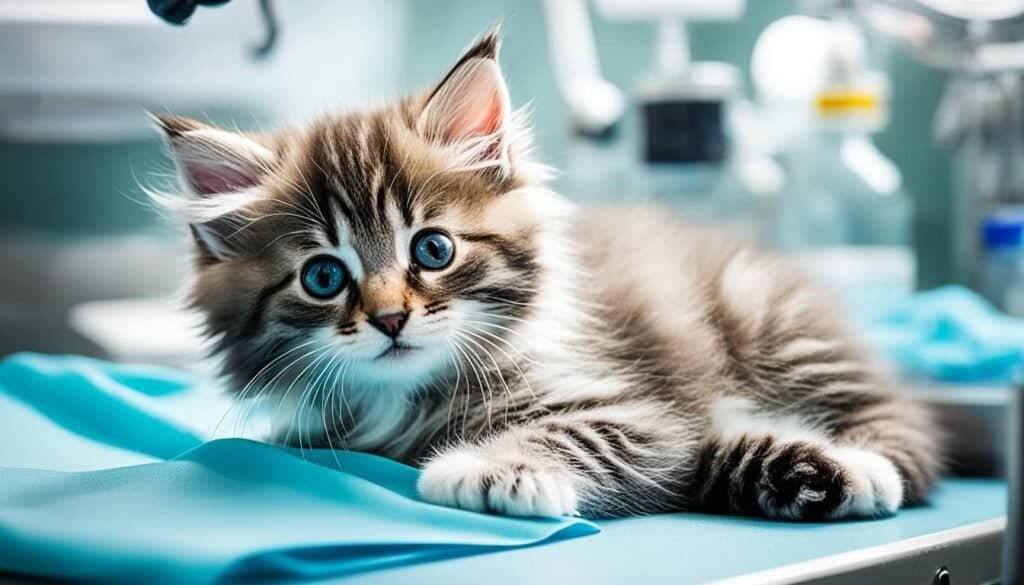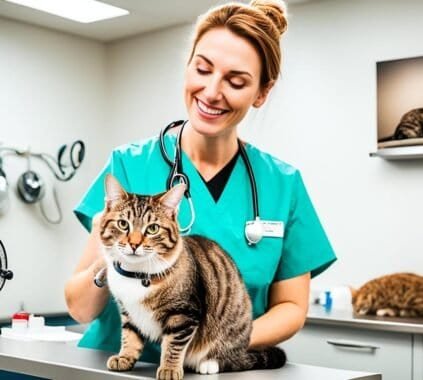Spaying and neutering are important procedures that offer numerous benefits for cats, their owners, and the overall community. These surgical procedures involve the removal of the reproductive organs of cats, ensuring that they cannot reproduce. In the Philippines, cat spaying and neutering are crucial for population control and responsible pet ownership.
Key Takeaways:
- Spaying and neutering reduce the chances of reproductive organ-related diseases in cats.
- These procedures eliminate or reduce behaviors associated with the heat cycle, such as spraying and marking.
- By controlling the cat population, spaying and neutering help reduce the number of homeless animals.
- Cat spaying and neutering are affordable options in the Philippines, with low-cost options available.
- Responsible pet owners should prioritize spaying and neutering to contribute to population control efforts.
The Spaying and Neutering Process
When it comes to getting your cat spayed or neutered, understanding the process is essential. This procedure involves surgically removing the reproductive organs, ensuring that your cat cannot reproduce. Many pet owners choose to have their cats spayed or neutered at a spay-neuter clinic due to the affordability and specialized care they offer.
Before the surgery can be scheduled, there are a few requirements to consider. Cats should be at least 6 months old and in good health to undergo the procedure. Some clinics may also request blood tests to evaluate your pet’s suitability for surgery. It’s worth noting that certain cases may require additional tests or procedures.
Prior to the appointment, pet owners may be asked to provide photos of their cats. These images help the clinic assess the cat’s breed, weight, and any additional factors that may impact the surgery. It’s important to follow all pre-surgery instructions given by the clinic, which may include fasting your cat for 10 hours before the procedure.
Spay-Neuter Clinic: Affordable Options
Spaying and neutering your cat at a dedicated spay-neuter clinic offers afforda advantue sds like low-cost or discounted rates. These clinics specialize in spaying and neutering procedures, ensuring that your cat receives expert care while keeping the costs down. The cost of spaying or neutering can vary depending on factors such as the cat’s breed, weight, and any additional procedures required.
While the exact prices may vary, typical costs for spaying or neutering in the Philippines range from Php 700 to Php 1500. Native cats and dogs often qualify for discounted rates, while mixed or purebred cats may have slightly higher fees. Additional charges may apply for pregnant cats or those with undescended testicles or pyometra.
To give you a better idea, here is an example of the average costs for spaying and neutering at a spay-neuter clinic:
| Procedure | Cost (Php) |
|——————|————|
| Spaying (Female) | 850 |
| Neutering (Male) | 700 |
Please note that these costs are sample prices and may vary depending on the clinic and cat’s specific needs. It’s recommended to inquire at your local spay-neuter clinic for accurate pricing.
Remember, opting for a spay-neuter clinic not only saves you money but also supports responsible pet ownership and helps control the cat population in the Philippines.
Benefits of Cat Spaying and Neutering
Spaying and neutering are essential procedures that offer numerous benefits for cats, their owners, and the community. By preventing unwanted litters, these procedures play a crucial role in controlling the cat population and reducing the number of homeless animals in the Philippines.
One of the key advantages of spaying and neutering is the reduced risk of certain health issues. Female cats that are spayed have a lower chance of developing uterine infections, ovarian cysts, and breast cancer. Neutered male cats, on the other hand, are protected against testicular cancer. These procedures promote the overall well-being and longevity of cats.
Moreover, spaying and neutering eliminate or reduce behaviors associated with the heat cycle. Female cats in heat often exhibit spraying and marking behaviors, which can be disruptive and difficult to manage for both cat owners and communities. Neutered male cats are less likely to engage in aggressive behaviors and have a decreased tendency to roam in search of a mate. By reducing these behaviors, spaying and neutering contribute to a more peaceful and harmonious household.
Furthermore, one of the significant benefits of cat spaying and neutering is population control. Preventing unwanted litters helps address the issue of overpopulation and the resulting strain on animal shelters and rescue organizations. By promoting responsible pet ownership through spaying and neutering, we can ensure a healthier and more balanced cat population in our communities.
“Spaying and neutering not only benefit individual cats and their owners, but they also have a positive impact on society as a whole. These procedures are a crucial step towards reducing the number of homeless cats and promoting responsible pet ownership.”
Benefits of Cat Spaying and Neutering:
- Prevents unwanted litters, contributing to cat population control
- Reduces the risk of uterine infections, ovarian cysts, breast cancer, and testicular cancer
- Eliminates or reduces spraying, marking, and aggressive behaviors associated with the heat cycle
- Promotes the overall well-being and longevity of cats
| Benefits | Spaying | Neutering |
|---|---|---|
| Prevents unwanted litters | ✓ | ✓ |
| Reduces the risk of reproductive organ-related diseases | ✓ | ✓ |
| Eliminates or reduces spraying and marking behaviors | ✓ | ✓ |
| Reduces aggression and roaming tendencies | – | ✓ |
| Contributes to cat population control | ✓ | ✓ |
Affordable Options for Cat Spaying and Neutering
In the Philippines, pet owners have access to affordable options for cat spaying and neutering. Many spay-neuter clinics offer discounted rates specifically for native cats and dogs. The prices for these procedures typically range from P700 to P1,500.
However, it is important to note that additional fees may apply in certain cases. For example, mixed or purebred cats may have different pricing structures. Pregnant cats or dogs, as well as cats or dogs with undescended testicles or pyometra, may also require additional procedures and incur additional costs.
Some spay-neuter clinics go a step further by offering discounted rates for organizing community outreach programs. This enables communities to come together and address the issue of cat population control in a cost-effective manner.
Given the affordable options available, pet owners in the Philippines are encouraged to consider spaying and neutering as part of responsible pet ownership and population control efforts.
Benefits of Choosing Affordable Options for Cat Spaying and Neutering
“Opting for affordable options for cat spaying and neutering not only benefits your own pet but also contributes to the larger community. By investing in these procedures, you are actively playing a role in controlling the cat population and reducing the number of homeless animals.”
When considering the affordability of cat spaying and neutering, it’s important to remember that the cost of these procedures is significantly lower compared to the potential expenses associated with caring for an unplanned litter or addressing the health issues that can arise when cats are not spayed or neutered.
By choosing affordable options for cat spaying and neutering, pet owners can ensure that their cats lead healthier lives and contribute to the overall well-being of the community.
| Procedure | Affordable Price Range |
|---|---|
| Spaying (Female Cats) | P700 – P1,500 |
| Neutering (Male Cats) | P700 – P1,500 |
| Additional Fees: | |
| – Mixed or Purebred Cats | Varies |
| – Pregnant Cats or Dogs | Varies |
| – Cats or Dogs with Undescended Testicles or Pyometra | Varies |
The Importance of Cat Spaying and Neutering
Cat spaying and neutering play a crucial role in managing the cat population and addressing the issue of stray and homeless animals. By preventing unwanted litters, these procedures help reduce the strain on animal shelters and prevent euthanasia due to overcrowding. Additionally, spaying and neutering have numerous health benefits for cats, including reducing the risk of reproductive organ-related diseases and certain types of cancer. Moreover, these procedures help improve the overall behavior of cats, making them more docile and less prone to aggression. Responsible cat owners should prioritize spaying and neutering to contribute to the well-being and control of the cat population.

Spaying and neutering are essential for controlling the cat population and preventing the euthanasia of stray and unwanted cats.
The Benefits of Spaying and Neutering
Spaying and neutering have numerous advantages for both the cats and the community:
- Population Control: By preventing unwanted litters, spaying and neutering help reduce the number of stray and homeless cats, ultimately contributing to population control.
- Health Benefits: These procedures significantly reduce the risk of reproductive organ-related diseases, such as uterine infections, breast cancer, ovarian cysts, and testicular cancer.
- Behavioral Improvement: Spaying and neutering can help minimize aggressive behaviors in cats, making them more docile and less likely to engage in territorial marking, spraying, and fighting.
- Longevity: Neutered cats tend to have longer lifespans, as they are less prone to certain health issues and are at a lower risk of roaming and engaging in dangerous behaviors.
The Role in Community and Pet Well-being
The importance of spaying and neutering extends beyond individual cats. These procedures contribute to the overall well-being of communities and the animals in their surroundings:
- Reduces Stray Cat Population: By preventing unwanted litters, spaying and neutering help decrease the number of stray and feral cats, leading to cleaner and safer neighborhoods.
- Promotes Responsible Pet Ownership: Encouraging spaying and neutering educates pet owners about the importance of population control and responsible pet care.
- Aids Animal Shelters: By reducing the number of unwanted cats, spaying and neutering alleviate the burden on animal shelters, allowing them to provide better care and resources for animals in need.
The Impact of Cat Spaying and Neutering on Communities
Cat spaying and neutering have a positive impact on communities. These procedures play a crucial role in cat population control, ensuring a harmonious coexistence between cats and humans. By reducing the number of homeless and unowned cats in communities, spaying and neutering alleviate various challenges that arise from uncontrolled cat populations.
One significant benefit of cat spaying and neutering is the reduction in instances of defecation in public areas. Unneutered male cats are more likely to mark their territory by spraying urine, causing an unpleasant odor and hygiene issues. By addressing this behavior through neutering, communities can enjoy cleaner environments and a safer, more comfortable living space.
Additionally, spaying and neutering help reduce the potential for aggression towards humans. Unaltered cats, especially males, often exhibit territorial aggression, which can lead to conflicts and potential harm to individuals. Spaying and neutering significantly reduce aggressive behaviors, contributing to a safer community for both cats and humans.
Furthermore, the overall health and welfare of cats in communities are improved through spaying and neutering. These procedures help prevent certain reproductive organ-related diseases and reduce the risk of various types of cancers. By promoting the well-being of cats, communities can ensure that their feline residents lead healthier and happier lives.
To further support the success of cat spaying and neutering initiatives, it is crucial for communities and individuals to actively promote and educate others about the benefits of these procedures. Encouraging responsible pet ownership and advocating for population control measures are essential steps towards creating sustainable and thriving communities.
The Process of Kitten Neutering
Neutering kittens is a vital aspect of responsible pet ownership and population control. This process involves the surgical removal of the reproductive organs of kittens, either partially or in their entirety. Kittens can undergo two different procedures based on their sex.
For male kittens: The procedure is known as castration, where the testicles are surgically removed. This eliminates their ability to reproduce and significantly reduces the risk of testicular diseases.
For female kittens: The procedure is called spaying, which involves the removal of the ovaries and uterus. By eliminating the risk of uterine infections and reducing the chances of certain reproductive tract cancers, spaying ensures better long-term health for female kittens.
Kitten neutering plays a crucial role in preventing unwanted litters and controlling the population of cats. By opting for these procedures, pet owners contribute to a healthier and more sustainable feline community.

Benefits of Kitten Neutering
Kitten neutering plays a crucial role in population control and offers a range of benefits for both kittens and their owners. By preventing unwanted litters, neutering helps reduce the strain on animal shelters and rescue organizations, contributing to a healthier cat population and a more balanced ecosystem. Additionally, kitten neutering has several health benefits that improve the overall well-being of the kittens.
When female kittens are spayed, their reproductive organs are removed, eliminating the risk of uterine infections, ovarian cysts, and certain types of cancer. This surgical intervention not only improves their health but also increases their lifespan and quality of life. On the other hand, male kittens benefit from castration, which involves removing their testicles. This procedure reduces aggressive behaviors influenced by male hormones and eliminates the risk of testicular disease, ensuring a calmer temperament and a more peaceful environment.
By neutering kittens, owners can prevent roaming and mating behaviors commonly associated with intact felines, promoting a safer and more controlled living environment. These procedures reduce the likelihood of kittens running away or getting into fights, protecting them from potential injuries and diseases. Neutered kittens are less likely to display territorial markings, aggression, or behaviors related to heat cycles, making them easier to train and integrate into households. Moreover, neutering contributes to stronger social bonds between kittens and their owners, fostering trust and companionship.
Overall, kitten neutering is a responsible choice that guarantees the long-term well-being of kittens and helps maintain a sustainable cat population. The benefits extend beyond individual pets and positively impact communities by reducing the number of stray or homeless kittens. By prioritizing kitten neutering, owners actively participate in population control efforts and become advocates for responsible pet ownership.
| Benefits of Kitten Neutering |
|---|
| Prevents unwanted litters |
| Reduces the strain on animal shelters |
| Eliminates the risk of uterine infections, ovarian cysts, and certain types of cancer in female kittens |
| Reduces aggressive behaviors influenced by male hormones in male kittens |
| Eliminates the risk of testicular disease in male kittens |
| Creates a calmer temperament and a more peaceful environment |
| Prevents roaming and mating behaviors |
| Reduces territorial markings, aggression, and behaviors related to heat cycles |
| Fosters stronger social bonds between kittens and their owners |
| Contributes to sustainable cat population control |
The Right Age for Neutering Kittens
While there is ongoing debate about the optimal age for neutering kittens, most veterinarians recommend getting kittens neutered or spayed at around five to six months of age. This age ensures that the kittens are sexually mature but have not yet experienced a heat cycle or exhibited mating behaviors. However, it is important to consult with a veterinarian to determine the best timing for your specific kitten, as each cat may have unique factors to consider. Early neutering can help prevent unwanted litters and unwanted behaviors associated with the heat cycle.
Neutering kittens at the appropriate age not only helps control the cat population but also provides various health benefits. By spaying female kittens, you can eliminate the risk of uterine infections, ovarian cysts, and certain types of cancer. For male kittens, castration reduces aggressive behaviors influenced by male hormones and eliminates the risk of testicular diseases.
It’s crucial to note that the decision of when to neuter your kitten should be made in consultation with a veterinarian. They will consider factors such as the kitten’s overall health, breed, and specific needs to determine the most suitable timing for the procedure. With their expertise, they can guide you in providing the best care for your kitten.
Conclusion
Cat spaying and neutering are crucial procedures that provide numerous benefits for cats, their owners, and communities. These procedures not only help prevent unwanted litters but also contribute to responsible pet ownership. By reducing the cat population, spaying and neutering alleviate the strain on animal shelters and rescue organizations, ensuring that every cat has a loving home.
One of the key advantages of cat spaying and neutering is the significant health benefits it offers. These procedures reduce the risk of certain diseases and behavioral problems associated with the heat cycle. Female cats are less likely to develop breast cancer and pyometra, while male cats are protected from testicular cancer. Moreover, spaying and neutering eliminate the need for heat cycles, reducing behavioral changes and the tendency to roam outdoors.
It is important for cat owners in the Philippines to prioritize spaying and neutering to ensure the overall well-being of their feline companions and contribute to population control efforts. By acting responsibly and getting their cats spayed or neutered, pet owners can play an active role in creating a healthier and happier cat population. Let us all work together to promote and support spaying and neutering programs to ensure a better future for cats in the Philippines.
FAQ
What is spaying and neutering?
What are the benefits of spaying and neutering?
What is the spaying and neutering process?
Why is cat population control important?
What are the affordable options for cat spaying and neutering?
How does spaying and neutering impact communities?
What is kitten neutering?
What are the benefits of kitten neutering?
When is the right age for neutering kittens?
What is the importance of cat spaying and neutering?
What are the benefits of spaying and neutering?
Last modified: February 19, 2024














[…] or spaying cats can have numerous health and behavioral benefits for both male and female felines. This procedure, performed by a veterinarian, involves removing […]
[…] summary, wet cat food offers the benefits of hydration, enhanced palatability, and urinary tract health support. By including wet cat food in […]
[…] and recognizing common illnesses in cats is crucial for cat owners in the Philippines. By being aware of the symptoms and knowing how to provide proper care and treatment, cat owners […]
[…] is important to emphasize that spaying or neutering cats at a young age is highly recommended to ensure the maximum benefits. The procedure is generally safe and can be performed as early as 8 weeks of age, following the […]
[…] By enrolling in a pet wellness plan, cat owners can experience several significant benefits: […]
[…] Spaying or neutering Siamese cats can also contribute to their overall health and lifespan. It helps prevent certain reproductive-related health issues and reduces the risk of certain cancers. […]
[…] cat owners know the benefits of spaying their cats. It stops overbreeding and keeps your pet healthy. Let’s take a closer look at why […]